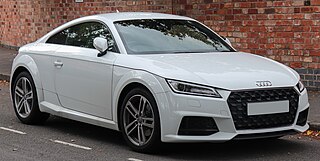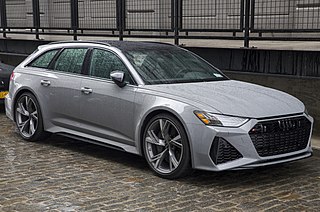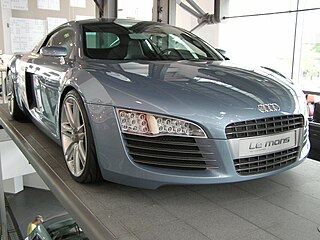
Audi AG is a German automotive manufacturer of luxury vehicles headquartered in Ingolstadt, Bavaria, Germany. As a subsidiary of its parent company, the Volkswagen Group, Audi produces vehicles in nine production facilities worldwide.

Volkswagen, abbreviated as VW, is a German motor vehicle manufacturer headquartered in Wolfsburg, Lower Saxony, Germany. Founded in 1937 by the German Labour Front under the Nazi Party and revived into a global brand post-World War II by the British Army Officer Ivan Hirst, it is known for the iconic Beetle and serves as the flagship brand of the Volkswagen Group, the largest automotive manufacturer by worldwide sales in 2016 and 2017. The group's biggest market is in China, which delivers 40 percent of its sales and profits. Its name is derived from the German-language terms Volk and Wagen, translating to "people's car" when combined.

The Audi TT is a series of 2-door production sports cars and convertibles, made by Audi since 1998, in its third generation since 2014. The first two generations were assembled by Audi's Hungarian subsidiary, one of the world's biggest engine making plants, using bodyshells manufactured and painted at Audi's Ingolstadt plant and parts made entirely by the Hungarian factory for the third generation.

The Volkswagen Touareg is a car produced by German automaker Volkswagen Group since 2002 at the Volkswagen Bratislava Plant. A five-seater crossover SUV, the vehicle was named after the nomadic Tuareg people, inhabitants of the Saharan interior in North Africa. As of its first generation, the Touareg was developed together with the Porsche Cayenne and the Audi Q7, and as of October 2020, the Touareg was developed together with the Audi Q8, the Bentley Bentayga and the Lamborghini Urus. The vehicles were designed as unibody SUVs with independent suspensions. The first generation (2002–2010) offered five, six, eight, ten and twelve-cylinder engine choices.

The Audi 80 is a compact executive car produced by the Audi subdivision of the Volkswagen Group across four generations from 1966 to 1996. It shared its platform with the Volkswagen Passat from 1973 to 1986 and was available as a saloon, and station wagon — the latter marketed by Audi as the Avant. The coupé and convertible models were not badged as members of the range but used a derivative of the same platforms.

The Audi A8 is a full-size luxury sedan manufactured and marketed by the German automaker Audi since 1994. Succeeding the Audi V8, and now in its fourth generation, the A8 has been offered with both front- or permanent all-wheel drive—and in short- and long-wheelbase variants. The first two generations employed the Volkswagen Group D platform, with the current generation deriving from the MLB platform. After the original model's 1994 release, Audi released the second generation in late 2002, the third in late 2009, and the fourth and current iteration in 2017. Noted as the first mass-market car with an aluminium chassis, all A8 models have used this construction method co-developed with Alcoa and marketed as the Audi Space Frame.

The Audi A4 is a line of luxury compact executive cars produced since 1994 by the German car manufacturer Audi, a subsidiary of the Volkswagen Group. The A4 has been built in five generations and is based on the Volkswagen Group B platform. The first generation A4 succeeded the Audi 80. The automaker's internal numbering treats the A4 as a continuation of the Audi 80 lineage, with the initial A4 designated as the B5-series, followed by the B6, B7, B8, and the B9. The B8 and B9 versions of the A4 are built on the Volkswagen Group MLB platform shared with several models and brands across the Volkswagen Group. The Audi A4 automobile layout consists of a front-engine design, with transaxle-type transmissions mounted at the rear of the engine. The cars are front-wheel drive, or on some models, "quattro" all-wheel drive. The A4 is available as a sedan and station wagon. Historically, the second (B6) and third generations (B7) of the A4 also included a convertible version. For the fourth generation (B8) and onwards, the convertible, along with a new coupé and 5-door liftback variant, was spun-off by Audi into a new nameplate called the Audi A5.

The Audi Quattro is a road and rally car, produced by the German automobile manufacturer Audi, part of the Volkswagen Group. It was first shown at the 1980 Geneva Motor Show on 3 March. Production continued through 1991.

The Audi R8 is a mid-engine, 2-seater sports car, which uses Audi's trademark quattro permanent all-wheel drive system. It was introduced by the German car manufacturer Audi AG in 2006.

The Audi Q7 is a crossover SUV made by the German manufacturer Audi, unveiled in September 2005 at the Frankfurt Motor Show. Production of this seven-seater SUV began in the autumn of 2005 at the Volkswagen Bratislava Plant in Bratislava, Slovakia.

The Audi RS 6 is a high-performance variant of the Audi A6 range, produced by the high-performance subsidiary company Audi Sport GmbH, for its parent company Audi AG, a subsidiary of the Volkswagen Group, from 2002 onwards.

Ferdinand Karl Piëch was an Austrian business magnate, engineer and executive who was the chairman of the executive board (Vorstandsvorsitzender) of Volkswagen Group in 1993–2002 and the chairman of the supervisory board (Aufsichtsratsvorsitzender) of Volkswagen Group in 2002–2015.

The International Motor Show Germany or International Mobility Show Germany, in German known as the Internationale Automobil-Ausstellung, is one of the world's largest mobility trade fairs. It consists of two separate fairs, that subdivided in 1991. While the IAA MOBILITY displays passenger vehicles, motorcycles and bikes, the IAA TRANSPORTATION specializes in commercial vehicles. Before the separation, the show was held solely at the Messe Frankfurt.

The Audi e-tron is a series of electric and hybrid cars shown by Audi from 2009 onwards. In 2012 Audi unveiled a plug-in hybrid version, the A3 Sportback e-tron, released to retail customers in Europe in August 2014, and slated for the U.S. in 2015. A decade after the unveiling of the first e-tron concept at the 2009 International Motor Show Germany, Audi's first fully electric e-tron SUV went into production in 2019.
The Volkswagen Group MLB platform is the company's platform strategy, announced in 2012, for shared modular construction of its longitudinal, front-engined automobiles.

The Audi Le Mans quattro is a concept car, developed by German automobile manufacturer Audi, for presentation at the 2003 Frankfurt Motor Show, to celebrate Audi's three successive wins at the arduous 24 Hours of Le Mans endurance race in 2000, 2001, and 2002. It was the third and final concept car designed by Audi in 2003, following the Pikes Peak quattro and the Nuvolari quattro.
Audi Sport GmbH, formerly known as quattro GmbH, is the high-performance car manufacturing subsidiary of Audi, a subsidiary of the Volkswagen Group.

The Lamborghini Urus is a luxury SUV manufactured by Italian automobile manufacturer Lamborghini. It was introduced in December 2017 as a 2018 model year production vehicle. The Urus is the first Lamborghini SUV and five-door vehicle in the modern era, and the second SUV in the brand's history after the LM002, which was produced between 1986 and 1993.

The Volkswagen Bratislava Plant is an automotive factory and co-located test track owned by Volkswagen Group in Bratislava, Slovakia.

The Audi R8 is the first generation of the R8 sports car developed and manufactured by German automobile manufacturer Audi. Conceived in 2003 in concept form, the R8 was put into production in June 2006. The Type 42 is based on the Lamborghini Gallardo and shares its chassis and engine. Audi's parent company Volkswagen Group owns Lamborghini as well and components of both of the cars were shared mainly to save development costs. Production of the Type 42 ended in August 2015, following the introduction of the Type 4S at the 2015 Geneva Motor Show which was based on an entirely new platform.


















